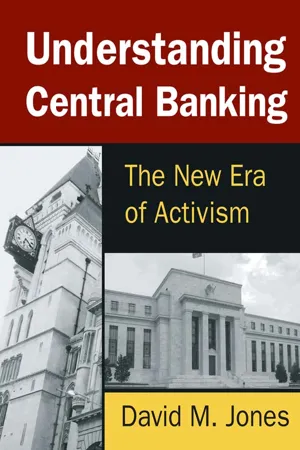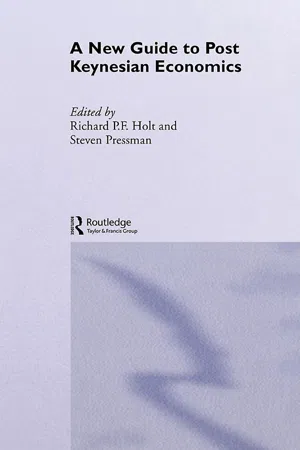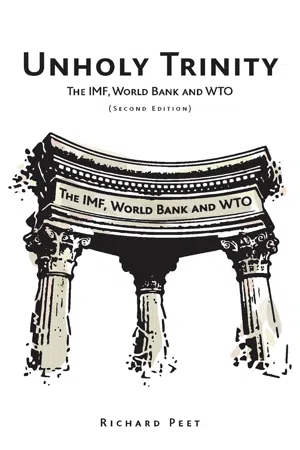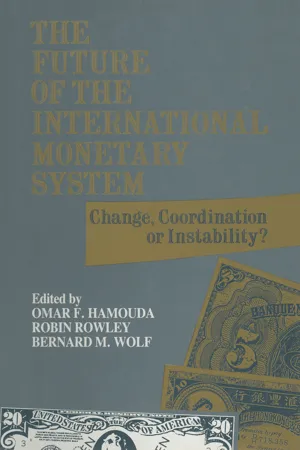Bretton Woods System
The Bretton Woods System was a monetary system established in 1944, which aimed to promote international economic stability and prevent another global economic depression. It created fixed exchange rates tied to the US dollar, and established the International Monetary Fund (IMF) and the World Bank to oversee international monetary cooperation and provide financial assistance to countries in need.
7 Key excerpts on "Bretton Woods System"
- eBook - ePub
- W. Charles Sawyer, Richard L. Sprinkle(Authors)
- 2020(Publication Date)
- Routledge(Publisher)
...At this conference, forty-four countries essentially created a new international monetary system. This system usually is described as the “Bretton Woods” system. 2 More precisely, this system is technically the gold-exchange standard. In this system, the U.S. dollar was tied to gold but all other currencies were tied to the dollar. In addition, the countries agreed to the creation of a new international monetary institution known as the International Monetary Fund (IMF). In this section, we consider how the Bretton Woods System functioned. Since this system and the IMF are inextricably bound together, we will also consider how the IMF played a key role in the operation of the international monetary system. The Bretton Woods System The purpose of the Bretton Woods System was twofold. First, countries had a strong desire to return to some form of international monetary system that featured fixed exchange rates. The period after the gold standard from 1914 up to World War II was characterized by exchange rates that were extremely unstable. Given that both business and governments had become used to stable exchange rates, this period of instability was very unsettling. Thus, the first objective of a new international monetary system was to develop some form of fixed exchange rates. The second purpose of the Bretton Woods System was to develop some method that would decouple the link between a balance of payments imbalance and the supply of money. In order to accomplish this objective, it was necessary to reduce the role that gold played in determining a country’s money supply. It became necessary to link currencies to something other than gold. Both of these objectives were satisfied in a rather unique manner. First, the price of gold was defined in terms of the U.S. dollar. The U.S. was to maintain the price of gold fixed at $35 per ounce. In addition, the U.S...
- eBook - ePub
Understanding Central Banking
The New Era of Activism
- David Jones(Author)
- 2014(Publication Date)
- Routledge(Publisher)
...These distinguished delegates, including the famous British economist John Maynard Keynes, who led the British delegation and generally distrusted the gold standard, were hoping to reestablish global financial and economic stability. The immediate aim was to regulate the international monetary and financial system. The Bretton Woods Agreement also led to the establishment of (1) the General Agreement on Tariffs and Trade (GATT) to promote increased global trade; (2) the International Bank for Reconstruction and Development (IBRD), today referred to as the World Bank, to facilitate postwar reconstruction and development; and (3) the International Monetary Fund (IMF) to provide temporary liquidity for countries suffering from current account deficits. The hope of these conference participants, as they sought to repair a shattered global financial system, was that the largest among industrial Western democratic nations would set an example by lowering trade barriers and removing capital controls. The idea was to encourage the free flow of goods, services, ideas, labor, financial capital, and direct investment across previously closed national borders. The Bretton Woods Conference, lasting from July 1 to July 22, 1944, was intended not only to speed up post-World War II reconstruction and development but also to expand global trade and investment while promoting global growth. (A treasure trove of information on the Bretton Woods Agreement, after three weeks of plenary, committee, and subcommittee sessions followed by cocktail parties lasting late into the night, can be found in recently discovered transcripts of the conference; see Schuler and Rosenberg 2012.) Under the gold exchange standard and its system of fixed exchange rates, the U.S. dollar was tied to gold at $35 per ounce, and the currencies of other countries were fixed in relation to the U.S. dollar. The U.S...
- eBook - ePub
- David Hudson(Author)
- 2014(Publication Date)
- Routledge(Publisher)
...It achieved its primary aim of facilitating the emergence of a liberal, open, multilateral international economic system. Plus, the stability it provided also presided over a historic ‘golden age’ of economic growth and development – at least for the major powers. Exchange rates remained stable, growth was rapid, inflation remained moderate and world trade expanded rapidly (Bordo and Eichengreen 1993). Nevertheless, the Bretton Woods regime collapsed in the 1970s. Two points need to be made about the system’s success. First, the actual operation and success of the system was underwritten by the US rather than the IMF and the World Bank, and second, the system had a fatal flaw. Ironically, this flaw arose from the system’s necessary, as it turned out, dependence on the US. This flaw is called the Triffin dilemma. Meanwhile, the Bretton Woods institutions – the IMF and World Bank – obviously continue to exist and remain important, though their specific roles have changed and adapted to the new international monetary regime – see Box 4.4 on the IMF. Box 4.4 The International Monetary Fund (IMF) The IMF was designed to manage and regulate the multilateral Bretton Woods currency system – to maintain stability, ensure that countries current accounts were open and manage the fixed par rates between countries. As part of this the IMF was to serve countries’ needs for short-term borrowing to cover temporary balance of payments deficits. The idea was that, unlike under the gold standard, governments should have more breathing space to turn around their deficits rather than being forced to immediately deflate their economy. However, with the end of the Bretton Woods multilateral system of pegged exchange rates the IMF’s future looked uncertain, despite the fact that it was crucial in legalising the switch to floating exchange rates through the 1978 amendment of its Articles of Agreement...
- eBook - ePub
- Sukumar Nandi(Author)
- 2017(Publication Date)
- Routledge India(Publisher)
...Second, there was little cooperation among the key members — Britain, France and the US. Two strong members, i.e., France and the US, were reluctant to follow the rules of the game. They created deflationary pressures in the world by persistent sterilization of their balance of payment surpluses. The system could not bear it and ultimately it collapsed with the Great Depression. But by that time it had transmitted deflation and depression across the world (Eichengreen, 1989; Friedman and Schwartz, 1963; Temin, 1989). 5.3 The Bretton Woods International Monetary System With the end of World War II, the victors assembled at Bretton Woods, New Hampshire, US, to build up the World Monetary System, which came to be known as Bretton Woods International Monetary System (BWIMS). The principal objectives were to remove the ills from the financial system and to create a stable world monetary order. For this several measures were adopted. First, the floating exchange rate system was stopped. Second, the gold exchange standard was scrapped as it was thought to be responsible for the international transmission of deflation in the early 1930s due to its vulnerability to the problems of adjustment, liquidity and confidence. Third, the new system sought to stop the beggar-thy-neighbour devaluation, trade restrictions, exchange controls and bilateralism prevalent after 1933. A group of economists led by J.M. Keynes, E.N. White and Ragnar Nurkse argued for an adjustable peg system, which was expected to combine the good features of stability of the exchange rate under the fixed-exchange-rate gold standard, on the one hand, and the monetary and fiscal independence under the flexible-exchange-rate standard, on the other. The coordination role of an international monetary agency was also planned. The latter was supposed to have considerable control over domestic financial policy of the members. But the two sides had differences over minor details...
- eBook - ePub
- Richard P. F. Holt, Steven Pressman(Authors)
- 2001(Publication Date)
- Routledge(Publisher)
...However, the Bretton Woods era was by no means a new gold standard. Only the US dollar could be exchanged for gold, and only by central banks. Also, Bretton Woods was never as rigid as the gold standard. Exchange rates were fixed but adjustable, and there were extensive capital controls. The system survived until August 1971, when the US cut the link between gold and the dollar. By early 1973 the main currencies were floating, and the contemporary non-system was in place. The dollar retained a key role; but by the 1990s, the US dollar, the Japanese yen, and the German mark (now replaced by the Euro) were each important in different areas of the world. Most commentators regard the performance of the international monetary system in the twentieth century as unsatisfactory. Volatile exchange rates combined with the globalization of financial markets, financial deregulation and liberalization, and technical change have greatly increased international capital movements. In balance of payments adjustment, the capital account, including speculative capital movements, tends to dominate the current account via exchange rate changes. Current account balances may no longer be perceived as deriving from genuine economic effort (e.g., surpluses arising when an economy becomes more competitive), but simply result as a byproduct of capital market activity. During the 1990s, the exchange rate mechanism (ERM) crisis in 1992/93, the Mexican peso crisis of 1994–95, and the Asian currency crises of 1997–98, all increased concerns about the international monetary system. Although most of these episodes involved attempts to keep exchange rates “pegged” at inappropriate levels, it is nonetheless easy to understand renewed contemporary interest in restructuring the international monetary system. The search for stability Many Post Keynesians have typically supported fixed exchange rates...
- eBook - ePub
Unholy Trinity
The IMF, World Bank and WTO
- Richard Peet(Author)
- 2009(Publication Date)
- Zed Books(Publisher)
...TWO Bretton Woods: emergence of a global economic regime While the world was still engaged in the Second World War, forty-four nations, led by the USA and the UK, met at Bretton Woods, New Hampshire, on 1–22 July 1944, to discuss economic plans for the post-war peace. Governing the international economy was an idea made possible by the anarchy of the inter-war period. In reaction, governments sought to secure world peace and prosperity through international economic cooperation. Such cooperation would be based on a world market, in which capital and goods might move freely, regulated by global institutions operating in the general interests of greater stability and predictability. Three regulatory institutions were envisaged: the IMF, the International Bank for Reconstruction and Development (IBRD, later known as the World Bank), and an International Trade Organization (ITO), which came into being only as the General Agreement on Tariffs and Trade (GATT), but much later became the WTO. The IMF and IBRD were formalized as organizations during the Bretton Woods conference, while the proposal for an ITO was part of a separate Havana Charter of 1947. This chapter looks at three aspects of the emergence of the new global economic accord. First I look at the political and economic conditions prevailing in the West between the late nineteenth century and the middle of the twentieth, the idea being to contextualize expressions of collective concern about the capitalist economy that led to Bretton Woods. Second, I outline the economic perspectives dominant at the time, from the intersection of which Bretton Woods policies emerged as a governance system for a world in crisis. Third, I look at the political economy of the conference itself, and the Bretton Woods model that resulted. Needless to say, these three lines are intertwined. My approach is historical-interpretive and historical-constructive...
- eBook - ePub
The Future of the International Monetary System
Change, Coordination of Instability?
- Omar F. Hamouda, Robin Rowley, Bernard M. Wolf(Authors)
- 2016(Publication Date)
- Routledge(Publisher)
...After all, the gold standard, which was more rigid than the Bretton Woods System, lasted nearly 100 years in the UK and about 40 years as a universal standard. The Bretton Woods System lasted 25 years before it broke down and had to be abandoned. In the past nine years, the European Monetary System has operated as a regional exchange system, with wider margins around central rates that are adjusted frequently. The gold standard lasted so long because it was believed by the public, and by most economists, that there could be no other satisfactory basis for a monetary system. Its long reign was marked by prolonged recessions, conditions which became intolerable by 1930 and led to its abandonment. The Bretton Woods System was able to last 25 years because it started with the US in an exceptionally strong payments position and huge gold reserves. The system collapsed because the US did not follow policies that would have offset the gradual deterioration in its relative international economic position and prevented the sharp depletion of its reserves. The EMS has been successful in maintaining orderly exchange markets, although exchange rates for its principal currencies have been far from stable. At present, the value of the Deutschmark in French francs is 47 per cent higher than at the end of March 1979, while it is less than 10 per cent higher in terms of the highly volatile dollar. The real achievement of the EMS was to facilitate the necessary adjustment of central rates in small steps to offset changes in the price-competitive position of its members. It will not be possible to restore a general system of par values even after the US balance of payments has been adjusted. That is mainly because of the differences in the policy objectives of the US, Germany and Japan on the level of employment, stability of prices and the appropriate balance of payments on current account...






